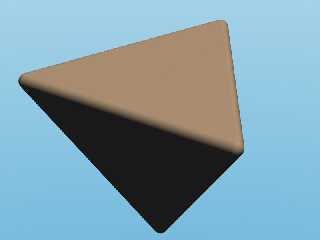|
 |
Right then, all you isosurface gurus out there: perhaps you can help me with
this.
Here's the problem. I'm trying to create a tetrahedral asteroid using an
isosurface. I've written a function which comprises four spheres, six
cylinders and a tetrahedron with its vertices and edges trimmed using a
functional intersection, merged to produce a perfect rounded tetrahedron
(first picture). I'm then boulderifying this base shape by adding crackle
and agate pigment functions.
No problem so far, I hear you say.
However, there appears to be a mismatch between the planar faces and the
curved edges which produces "fault lines" (second picture). I've tried
upping accuracy and max_gradient to no avail, and I've tried adding /
subtracting the pigment functions in various combinations - no good. Can
anyone shed any light on this bizarre artefact?
Source code, in case I'm being stupid:
// rounded tetrahedron function
// a is 'radius' of outcube
// b is radius of edge curves
#declare fn_rounded_tetra = function(x, y, z, a, b) {
min( // backside
max( (sqrt(0.5*(x+y)*(x+y) + (z-a)*(z-a)) - b),
(-x+y-2*a),
(x-y-2*a) ),
// frontside
max( (sqrt(0.5*(x-y)*(x-y) + (z+a)*(z+a)) - b),
(x+y-2*a),
(-x-y-2*a) ),
// topside
max( (sqrt(0.5*(x+z)*(x+z) + (y-a)*(y-a)) - b),
(-x+z-2*a),
(x-z-2*a) ),
// bottomside
max( (sqrt(0.5*(x-z)*(x-z) + (y+a)*(y+a)) - b),
(-x-z-2*a),
(x+z-2*a) ),
// leftside
max( (sqrt(0.5*(y-z)*(y-z) + (x+a)*(x+a)) - b),
(y+z-2*a),
(-y-z-2*a) ),
// rightside
max( (sqrt(0.5*(y+z)*(y+z) + (x-a)*(x-a)) - b),
(y-z-2*a),
(-y+z-2*a) ),
// vertices
f_sphere(x+a, y-a, z-a, b),
f_sphere(x-a, y-a, z+a, b),
f_sphere(x+a, y+a, z+a, b),
f_sphere(x-a, y+a, z-a, b),
// plane faces
max( (x+y+z -( (a*sin(radians(f_f)/2)+b) / sin(radians(f_f)/2) )),
(-x+y-z-( (a*sin(radians(f_f)/2)+b) / sin(radians(f_f)/2) )),
(x-y-z -( (a*sin(radians(f_f)/2)+b) / sin(radians(f_f)/2) )),
(-x-y+z-( (a*sin(radians(f_f)/2)+b) / sin(radians(f_f)/2) )),
(y - (a+b*cos(radians((180-f_f))/2))),
(-y - (a+b*cos(radians((180-f_f))/2))),
(x - (a+b*cos(radians((180-f_f))/2))),
(-x - (a+b*cos(radians((180-f_f))/2))),
(z - (a+b*cos(radians((180-f_f))/2))),
(-z - (a+b*cos(radians((180-f_f))/2))),
(-x+y+z - 2*(sqrt(3*a*a) + b*cos(radians((180-f_e))/2)) ),
(x+y-z - 2*(sqrt(3*a*a) + b*cos(radians((180-f_e))/2)) ),
(x-y+z - 2*(sqrt(3*a*a) + b*cos(radians((180-f_e))/2)) ),
(-x-y-z - 2*(sqrt(3*a*a) + b*cos(radians((180-f_e))/2)) ) ) ) }
#declare Boulder = isosurface {
function { fn_rounded_tetra(x,y,z,10,1)
+ fn_agate(x/4,y/4,z/4).gray*0.3
- fn_crack(x/4,y/4,z/4).gray*0.75 }
max_gradient 4
contained_by { box {-15, 15 } }
pigment { color White } }
Post a reply to this message
Attachments:
Download 'tetra2.jpg' (25 KB)
Preview of image 'tetra2.jpg'

|
 |




![]()